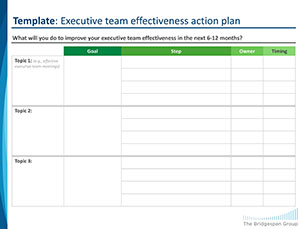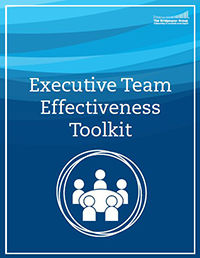Executive Team Effectiveness Toolkit
Practical tools for improving the effectiveness of nonprofit executive teams
Welcome to Bridgespan’s Executive Team Effectiveness Toolkit for nonprofit organizations! Through our research and experience working with nonprofits for nearly 20 years, we have distilled a sequence of five steps, framed as questions, that have helped many executive teams increase their overall effectiveness and move from good to great.
Is the CEO effectively managing the executive team?
Is the executive team focused on the most important work?
Does executive team composition support its ability to do the work?
Do meeting and communications processes support superior decisions and execution?
Does the team's dynamic foster the right conversations and results?
Why Use This Toolkit?
The purpose of this toolkit is to help you and your nonprofit executive team improve your effectiveness in one or more of these five areas. To get started, we recommend you and your team start by reading this article on executive team effectiveness and taking our 5-10 minute diagnostic survey on executive team effectiveness. To increase your team's effectiveness, it’s important to know which areas your team is strong in—and which areas need improvement. The effective executive team diagnostic helps teams explore this and pinpoint those key areas that will help them move from good to great in their work together. Use the results to determine where to start, or jump in to the toolkit below.
Take the Executive Team Effectiveness Diagnostic
After you've taken the diagnostic, the Executive Team Effectiveness Action Plan template can help you and your team plan and document what you'll improve on over the next year.
What Each Section Contains
The Executive Team Effectiveness Toolkit is broken into the following sections.
- CEO Management of the Executive Team
- Work of the Executive Team
- Executive Team Composition
- Executive Team Meetings
- Executive Team Dynamics and Behaviors
Each sections includes:
Introductory information about the challenges to address in each area
An easy-to-use tool to improve the effectiveness of your nonprofit executive team for each area:
- CEO checklist for leading executive teams
- An interdependence/stakes matrix that helps identify the work of the executive team
- Executive team composition questions
- Meeting agenda template
- Effective executive team behaviors examples
Process steps for how to use the recommended tool (where applicable)
An example of a tool-in-action from another nonprofit executive team (where applicable)
Peer perspectives from other nonprofit leaders with advice related to the overall topic and/or how they have used a specific tool
You can choose to walk through the entire toolkit below or jump into it by section using the above links.
Download the Executive Team Effectiveness Toolkit
You can download a PDF of the entire toolkit by clicking the button below. The 34-page PDF contains each of these steps in an easy-to-use format that can be shared and discussed with your nonprofit's executive team members. The button below will take you to a form to fill out to receive the download.
Download the Executive Team Effectiveness Toolkit
CEO Management of the Executive Team
CEO Management of the Executive Team
The executive team is the charge of the CEO. As head the head of the nonprofit organization, CEOs are accountable for results and responsible for determining what the executive team must do to achieve those results. Specifically, CEOs set expectations and define the executive team's work, steer meeting agendas, and support team members to grow while holding them accountable for performance. CEOs also maintain ultimate decision-making authority over what the team focuses on and how they do their work, while fostering strong relationships with team members.
Besides being clear on the CEO’s role, determining whether an executive team is even needed is important. Not all organizations need a group of senior leaders to come together to collaborate on leading the nonprofit organization. It is the responsibility of the CEO to determine whether or not an executive team is needed, and, if it is, to form the team that is best suited to the organization’s needs.
The following considerations could indicate that your organization would benefit from an executive team:
Is an executive team needed?

If you’ve said “yes” to these considerations, then you may be ready for an executive team.
Tools for Managing Executive Teams
CEO Checklist for Managing Executive Teams
In our research, every high-performing team we identified was led by a CEO who intentionally managed the team. This checklist highlights a number of steps nonprofit CEOs can take to more effectively lead their executive teams. Use it to assess your approach to executive team management and where it might need improvement.
Download the CEO Checklist for Managing Executive Teams | PDF >>
It’s important for any nonprofit CEO to maximize executive team effectiveness in service of the organization’s impact. Yet, inspiring high performance of the executive team isn’t easy. We spoke to three CEOs, Kirstin Chernawsky of Erie Neighborhood House, Eric Robbins of the Jewish Federation of Greater Atlanta, and Dorri McWhorter of YWCA Metropolitan Chicago, to learn how they approach leading their teams and which efforts have been particularly powerful.
Additional Resources
How to Lead High-Performing Nonprofit Executive Teams
Roxane White, former CEO and president of Nurse-Family Partnership, shares approaches used to encourage nonprofit executive team effectiveness.
How to Integrate Diversity, Equity, and Inclusion into Everyday Operations
This article by Maria Hernandez, practice leader for Global Consulting Solutions at InclusionINC, discusses the practices and behaviors that nonprofit leaders need to adopt in order to live into the commitment of integrating diversity, equity, and inclusion into their organizations.
When the Change Needs to Be You
This column by leadership consultant Nicki Roth helps leaders assess their need to change and offers guidelines for changing leadership behavior.
Build It and They Will Lead
The River Group, a leading consulting firm for for-profit executive teams talks about what CEOs must do to actively develop their executive team into a higher performing unit.
Work of the Executive Team
Work of the Executive Team
Getting clear about the most important things for the team to focus on—and just as important where it shouldn't spend its valuable time—is critical to determining who should participate and how the team should conduct its business. Clarity, however, eludes many teams. Only 19 percent of our survey respondents strongly agreed that their executive team focuses on the right work.
Download a PDF of this section
Typically, the right work involves guiding the nonprofit organization toward achieving its top priorities and ensuring cross-departmental decision making and resource allocation.
Is the executive team focused on the most important work?
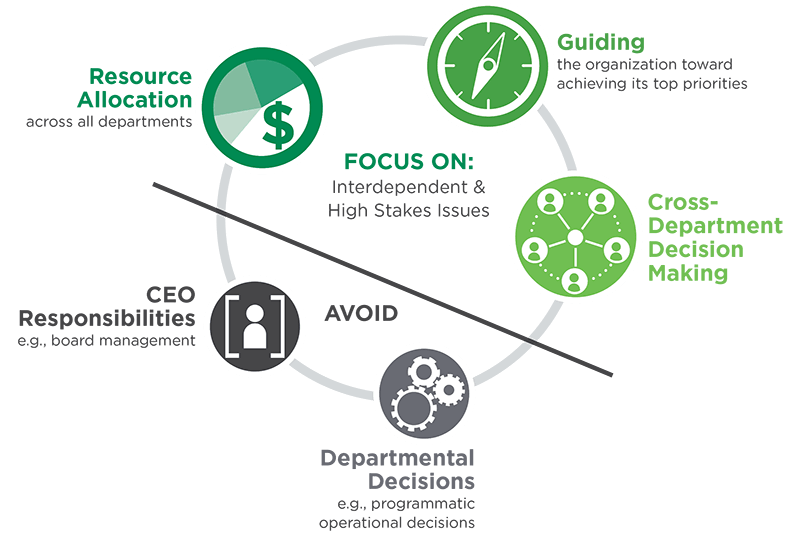
Definitions:
Interdependent Issues: Those involving multiple units or functions where cross-leader discussion is critical for effective decision making.
High Stakes Issues: Those having the most impact on the organization’s strategic clarity and priorities, programmatic and organizational effectiveness, development of future leaders, external reputation, and financial sustainability.
Tools for Identifying the Work
Tools for Identifying the Work
The Interdependence/Stakes Matrix helps nonprofit executive teams determine their priority activities and decisions. The tool (available as PDF and PowerPoint by clicking below) and step-by-step instructions will help you apply it to your executive team’s work.
- Download the Interdependence/Stakes Matrix | PDF >>
- Download the Interdependence/Stakes Matrix | PPT >>
- Download nonprofit matrices examples | PDF >>
Without clarity around the work they must do, many executive teams fall into a cycle of unproductive meetings and feelings of dissatisfaction with the impact they’re having on their organizations. One tool, the interdependence/stakes matrix, can help teams avoid these. Here several CEOs and a chief of staff describe how they’ve used the tool and how it’s benefited the work of their executive teams.
Additional Resources
How to Define the Work of Nonprofit Executive Teams
This Q&A with leadership expert Ruth Wageman looks at how to get teams focused on the priorities that will make the most of their valuable time.
Good Plow, Wrong Field
Leading consulting firm to for-profit executive teams, The River Group, shares how CEOs can ensure their executive teams are focused on the right work at the right level.
Executive Team Composition
Executive Team Composition
Finding the right combination of perspectives and competencies to fill an executive team is critical. At first, CEOs might be inclined to build a team composed of their direct reports, yet doing so could limit the diverse perspective needed for the work. Executive team members need to take a big-picture perspective and have business acumen, and non-direct reports may possess unique skills essential to the team's work. Diversity among executive team members also is another critical consideration.
Download a PDF of this section
Including all the right perspectives can sometimes be at odds with keeping the team a manageable size. In fact, many nonprofit executive teams are too big. CEOs who rate their teams as highly effective balance two critical questions:
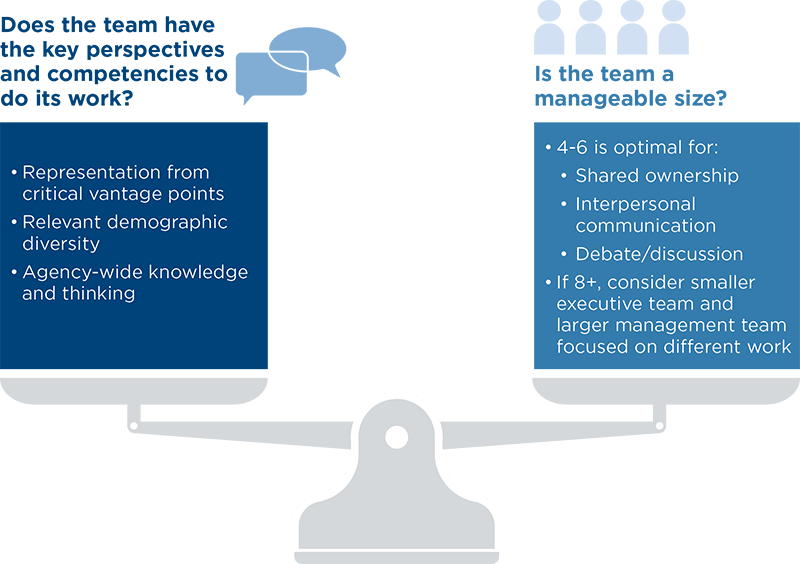
Finding this balance may not result in a group composed of the CEO’s direct reports, e.g.
- You may want fewer members if the CEO has a large number of direct reports.
- You may want to augment the team with other members if certain critical perspectives are missing.
Tools for Determining Executive Team Composition
Key Questions to Ask About Executive Team Composition
This one-pager walks you through three areas—optimizing team composition, considering two top teams, and evolving team composition—to help you assess where you have the right people on your team.
Download Key Questions About Executive Team Composition | PDF >>
Executive Team Composition: Peer Perspectives
Most nonprofit executive teams we’ve worked with have between four and six members. However, some CEOs prefer larger teams as a means to ensure the right perspectives are brought to bear for critical decisions. Other CEOs opt to balance the trade-offs inherent with larger teams and decision-making complexity and the desire for more perspectives by creating both a smaller executive team and a larger management team. The nonprofit leaders interviewed here share how they approached forming their executive teams.
Additional Resources
How Managers Become Leaders
Harvard Business Review author Michael Watkins, professor of Leadership and Organizational Change at IMD, discusses the required perspectives and capabilities for executive team effectiveness.
The Ballooning Executive Team
Harvard Business Review article by Jacques Neatby, an advisor to North American and European executive teams, shares how CEOs can address oversized executive teams.
How to Optimize Nonprofit Executive Team Composition
This Bridgespan Q&A with leadership consultant Nicki Roth takes a look at how CEOs can assess what they need to lead their organizations over the long haul; it provides a good starting point from which to consider who and what roles should be on the executive team.
Effective Executive Team Meetings
Effective Executive Team Meetings
Well-managed meeting and internal communications processes are essential for a successful nonprofit executive team. They require establishing the right practices, right amount time and location, and, often, pre-reads to prepare everyone for productive discussions. You can improve your meeting effectiveness through the following four steps, beginning with proactive preparation, and the downloadable tools found below.
Download a PDF of this section
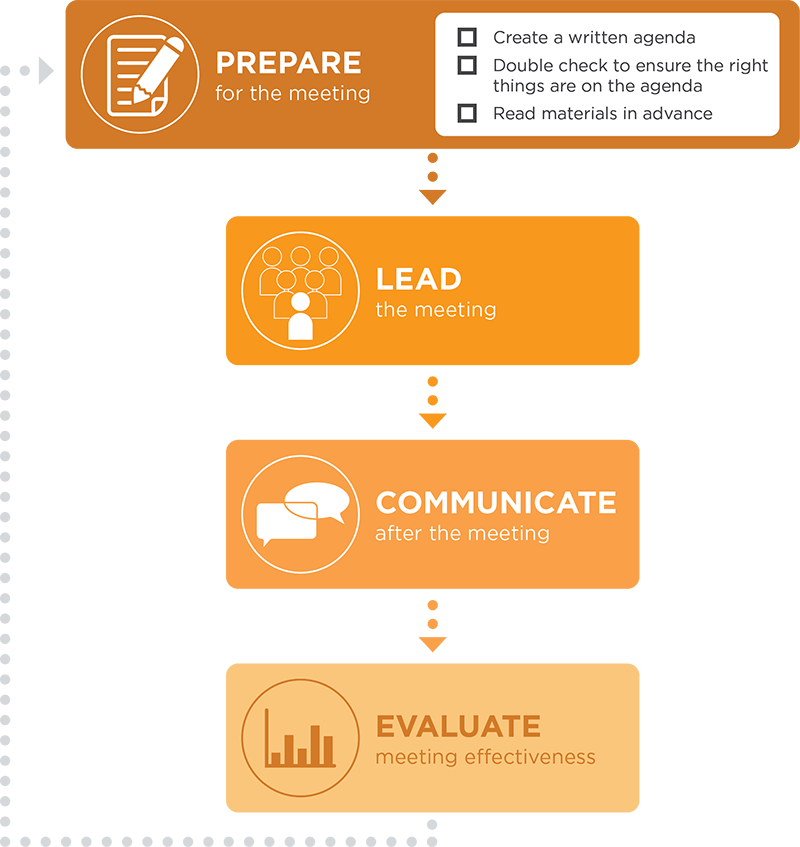
Tools for Effective Executive Team Meetings
Executive Team Meetings Agenda Templates
A well-planned agenda can go a long way to helping a meeting stay on track and achieve its purpose. This template can help you build an agenda for your next executive team meeting.
Download meeting agenda templates, instructions & examples:
Agenda template, instructions & examples | PDF>>
Meeting Agenda template | Excel >>
Meeting Agenda template | Word >>
Meeting Agenda example (KidsNGO) | PDF >>
Meeting Agenda example (Erie Neighborhood House) | Word >>
Download meeting wrap-up and updates templates:
Meeting Wrap-up template | PPT >>
Meeting Wrap-up example | PDF >>
Written Updates template | PPT >>
Effective Executive Team Meetings: Peer Perspectives
If your executive team suffers from unproductive meetings, it could be that you don’t have a good agenda setting process. Many executive teams have used the agenda template tool presented in this toolkit to help them achieve more effective meetings and communication processes. Here a number of nonprofit leaders share their approaches to making their meetings and communications more effective.
Additional Resources
Death by Meeting and Death by Meeting digital materials
Noted author and speaker on team effectiveness Pat Lencioni shares his approach to meetings, including activities and templates to guide implementation.
Making Every Meeting Matter
Harvard Business Review guide provides a variety of perspectives on making any meeting more effective.
The Meeting Advantage
This web-based tool developed by The Table Group, Pat Lencioni’s consulting firm, offers information on cultivating organizational health through strong meetings; subscription required.
How to Lead Effective Nonprofit Executive Team Meetings
This short article by a Bridgespan Partner Libbie Landles-Cobb identifies common mistakes and good practices to transform nonprofit executive team meetings from time sinks into engaging opportunities to really get things done.
Executive Team Dynamics and Behaviors
Executive Team Dynamics and Behaviors
Organizational success requires a cohesive executive team. A cohesive team sets the tone for the rest of the organization, modeling the importance of collaborative behavior. Yet despite its importance, many teams underinvest in developing a productive working dynamic tailored to their specific work. The set of dynamics below can help get you started. They support productive engagement for an executive team.
Download a PDF of this section
The six key dynamics for executive teams
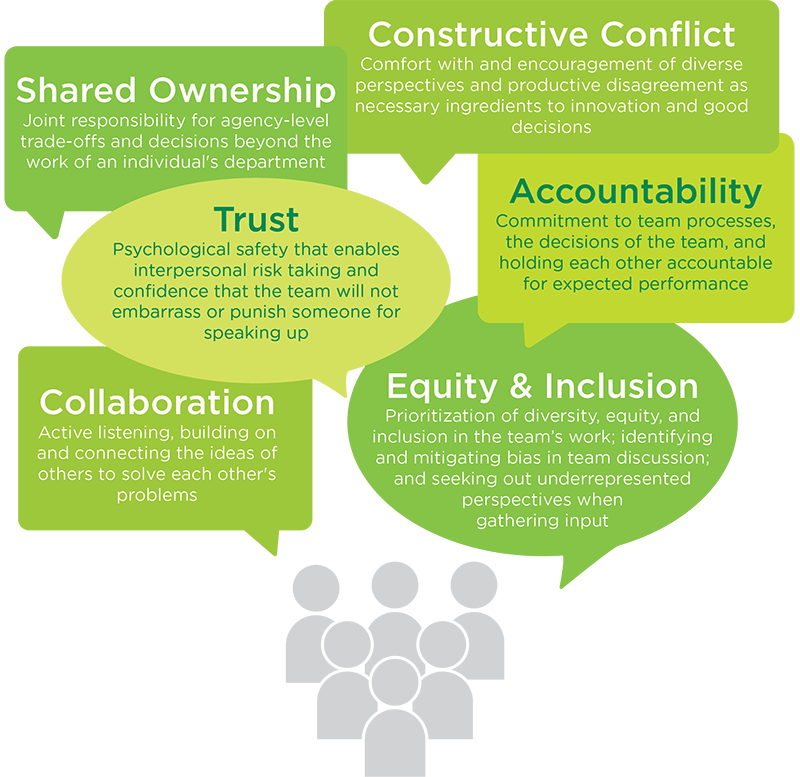
Tools for Executive Team Dynamics and Behaviors
Prioritizing Behavioral Norms
The steps outlined in this tool will help you prioritize a set of team behavioral norms that will support executive team effectiveness.
Download team behavioral norms template, instructions, & example | PDF >>
Download behavioral norms example from YWCA Metropolitan Chicago | PDF >>
Download behavioral norms example from a local affiliate | PDF >>
Executive Team Dynamics and Behaviors: Peer Perspectives
No two executive teams are alike when it comes to team dynamics and behaviors. Each team comprises a set of unique individuals, all of whom have their own approaches to work and personalities. Yet the effectiveness of the team relies on collaboration and alignment. One key lever a CEO can pull to ensure time together is well spent is to establish clear behavioral norms of how the team will work together.
Additional Resources
Decision making
Five Ways that Nonprofits Can Make Decision Making More Inclusive—and More Effective
This article, based on The Bridgespan Group’s work with scores of local, national, and global nonprofits and NGOs around decision making, looks at five promising approaches for making decisions in ways that are both inclusive and effective, leading to more equitable outcomes.
Structuring Leadership: Alternative Models for Distributing Power and Decision-Making in Nonprofit Organizations
This article from the Building Movement Project highlights distributed leadership structures, including elements and practices that must be in place for alternative models to work and common indicators of success.
Team dynamics
High-Performing Teams Need Psychological Safety. Here’s How to Create It
Author Laura Delizonna, executive coach and Stanford University instructor, discusses the importance of trust for high-performing teams and how teams can increase their level of psychological safety in this Harvard Business Review article.
How to Support Effective Dynamics in Nonprofit Executive Teams
Peter Thies, president of Boston-based consultancy The River Group, offers a glimpse inside his playbook for developing effective nonprofit executive teams, highlighting the team dynamics that support collaboration.
Personal Histories Exercise
Developed by the Table Group, this exercise helps improve trust by giving team members an opportunity to demonstrate vulnerability in a low-risk way and to help team members understand one another at a fundamental level so that they can avoid making false attributions about behaviors and intentions.
Team Effectiveness Exercise
Another exercise from the Table Group, this team effectiveness exercise gives team members a forum for providing one another with focused, direct, actionable feedback about how their individual behavior can improve the performance of the team.
Peer Perspectives
The nonprofit leaders featured in the Peer Perspectives here share how they've used this toolkit to build effective nonprofit executive teams. Short descriptions of these leaders and their organizations appear below. To read the individual articles for each of the five areas, please click on the links below.
Nonprofit Organizations Featured in This Toolkit

Kirstin Chernawsky, Executive Director, Erie Neighborhood House
Based in Chicago, Erie Neighborhood House provides programs for Latinx immigrants alongside individuals and families of all backgrounds focused on education, critical services, and trauma-informed care. They have around 200 employees and an annual budget of around $9 million.

Dorri McWhorter, CEO, YWCA Metropolitan Chicago
The YWCA Metropolitan Chicago provides comprehensive services to women and families spanning economic empowerment, health and wellness, STEAM and youth programming, early childhood education, family support, and sexual violence support services. It also provides workplace solutions to advance diversity, equity, and inclusion. It has nearly 200 employees and a $24 million an annual budget.

Eric Robbins, President/CEO, Jewish Federation of Greater Atlanta (JFGA)
JFGA cares for, connects and strengthens the Jewish community throughout greater Atlanta, Israel, and the world. Federation has a professional staff of around 75 and an annual budget of $11 million.
![]()
Featured Healthcare Organization
This healthcare organization provides medical services in Illinois. They have around 300 employees.
Additional Executive Team Resources
All of the resources shared in this toolkit can be found in this article. The list includes resources written by Bridgespan authors as well as external experts in nonprofit leadership and management. Bookmark the resource list to have quick access to answers to your questions about effective nonprofit executive teams.
Download the Executive Team Effectiveness Toolkit
Please fill out the form below to download the toolkit. We use the information we collect to help us improve our content and to inform our funders about the impact of our work. We will never share your personal information with any third party without your permission.
If you'd rather not share your information, you can download a copy of the PDF directly.

